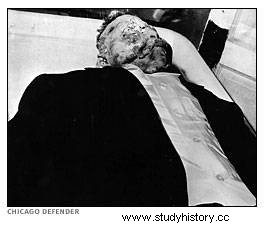Before his death, 14-year-old Emmett Till was tortured for long hours. The torturers hit him so hard that his face turned into a shapeless, bloody mask. Then he was killed with a single shot to the temple, and the corpse, bound with barbed wire, was thrown into a nearby river. The murder of this black boy changed the face of America forever.
The struggle for racial equality in the US dates back to the 19th century. Over the decades that followed, the status of the black section of American society gradually improved, but racial segregation and racism continued to be common in America. One of the cruelest examples of this type of attitude was the murder of 14-year-old Emmett Till. The boy's death, his funeral, and the trial of the murderers were events that shocked American society and started the fight for African American rights .
Mississippi on fire
The first real action that was taken after years of neglect to protect the rights of the black people of the United States was the sentence in the so-called Brown v. Topeka Board of Education. In 1954, the US Supreme Court ruled that racial segregation in schools was against the US constitution. This judgment was not welcomed everywhere. In Mississippi, the court order was viewed as an attack on the "southern way of life" and staunchly opposed to any attempt to end racial segregation . There were mass protests from the white part of the society, and public opinion fueled hostile moods. All of this has led to an increase in the number of acts of violence against black people. On August 13, 1955, an African American rights activist was shot dead in broad daylight in downtown Brookhaven. Not a single witness of the incident came to the police. A week later, a 14-year-old boy named Emmett Till came on vacation to the Mississippi, plunged in racist fever.
"Bobo"
Emmett Till grew up in Chicago. The Windy City was then the second largest urban center in the USA. Out of over 3 million of its inhabitants, about 500 thousand. was African American. There was racial segregation in Chicago as well, but in an ever-expanding metropolis, the black population had far better living conditions than in the backward South. A perfect example of a chance taken was Emmett's mother, Mamie Till. She was a civilian employee of the American military with a salary not much different from the national average. This allowed her to raise her son to be a confident young man.

The house where Emmett Till lived with his mother in mid-1955.
Emmett Till, nicknamed "Bobo" by his colleagues, was a type of happy rascal. He was the life of the party and, like most boys his age, he loved jokes and playing with his peers. In late August 1955, he and his cousin went on a short vacation to his uncle, Mose Wright, in the Mississippi town of Money. His mother was aware of the African American situation in the South of the USA, so she sensitized the young boy to refrain from mischief and always be polite towards white people . When she was saying goodbye to her son on August 20, 1955, she did not know that this was the last time she saw him alive.
Southern hospitality
It is not known whether Emmett disregarded or forgot his mother's advice, but a few days after arriving at his uncle, he procured a tragic incident. On August 24, he and a group of friends went to a local store to buy some sweets. To this day, it is not known what exactly happened on the spot. Probably, wanting to show off to his friends, the boy whistled to Carolyn Bryant behind the counter . For Emmett, who had been raised in Chicago, it was just an innocent joke, but his colleagues knew that he had violated southern taboos. He "insulted" the white woman. However, when for the next days there was no reaction from the local inhabitants, the boy was sure that the matter would spread to his bones. Unfortunately he was wrong.

On August 24, he and a group of friends went to a local store to buy some sweets
On August 28, at 2.30 am, Carolyn Bryant's husband, Roy Bryant, and his half-brother J. W. Milam, arrived at Uncle Emmett's house. The men burst inside the house and terrorized the household with a gun. They then pulled Emmet out of bed, packed him on a truck, and drove away in an unknown direction. Later it turned out that he was taken to an abandoned barn. There they beat and tortured the boy for hours . According to their later words, they wanted Emmet to be an example of what happens when black people "dominate" the south too much. When the torture was over, they took him to the bank of the nearby river and killed him with a shot to the head.
Mother's tears
When on August 31, while fishing, one of the local residents noticed a body sticking out of the water, he knew that it might be a boy who had been wanted for three days. Earlier, Roy Bryant and J. W. Milam had already been arrested for kidnapping Emmett. When the county sheriff arrived at the river he saw a gruesome sight. The body was immensely swollen, and the boy's head turned into a grotesque, death mask. The skull was literally falling to pieces. There was a large gunshot wound near the temples. The boy had nearly all of his teeth knocked out and his eye gouged out. So that the corpse did not come to the surface, they were wrapped with barbed wire to which a large metal fan was attached . Mose Wright, the boy's uncle, managed to identify the body only thanks to the ring on one of the fingers. In order to close the case as soon as possible, the sheriff ordered that the body be placed in the grave on the same day. When Mamie Till found out about the finding of the body, she demanded that her son's remains be sent home immediately.

The funeral that took place a few days later was held with the coffin open
The coffin with the boy's body arrived in Chicago, and the boy's mother had to deal with the sight of her son's mutilated body. In an act of despair, the woman decided that the whole world must see what the people of the South did to her boy. The funeral that took place a few days later was held with an open coffin. Earlier, for three days, the body was exposed to the sight of mourners who came to the ceremony en masse and could see the battered corpse with their own eyes . Later, terrifying photos of Emmett's face were also published in Jet magazine. They caused shock and disbelief throughout American society. Meanwhile, his murderers were being tried in Mississippi.
Black &White
The trial began on September 19, 1955 in Sumner, Mississippi. The entire United States had already lived with the murder of Emmett Till, and hundreds of journalists had flocked to the small town in the south. During the trial, the testimony of Mose Wright, who indicated that it was Roy Bryant and J. W. Milam, had broken into his house and abducted the boy. Until now, the accusation of a white man of a crime was unheard of for the black Mississippi community. Emmett's uncle broke this taboo with his testimony .

Emmett Till's mother during her son's funeral
Throughout the trial, the defendants of the accused tried to challenge the testimony of witnesses and discredit the material evidence. The defendants, on the other hand, were observing the events taking place in the courtroom with disdain and did not seem to care about the charges against them. The most emotional moment of the trial was the testimony of the murdered's mother. Mamie Till - despite the tragedy that befell her - answered her questions with calm and composure . During the closing speeches, the defendants' defense attorneys referred to purely racist and "Anglo-Saxon" values. They argued that the whole thing was a media campaign and an attack on the lifestyle of the people of the South. A jury of all white men reached the verdict for only about an hour. On September 23, at 2:34 PM, the hearing judge, Curtis Swango, read the verdict. The men were acquitted.
Beginning of end
Immediately after the trial was over, there were mass protests across the United States. Their participants criticized the verdict. The boy's death became the subject of heated nationwide debate and mobilized the black people of the United States to fight for their rights. Meanwhile, J. W. Milam and Roy Bryant became the target of social ostracism and ran into financial difficulties. Two years after the trial, looking for an opportunity to get money and knowing that they could not be convicted again, they gave a shocking interview to the newspaper "Look" . In it, they confessed to killing Emmett Till and described their crime in detail. Before that, however, on December 1, 1955, Rosa Parks had refused to give way to a white man and started the famous bus boycott in the town of Montgomery. Parks later became one of the symbols of the fight for black rights. She admitted years later that when she broke the prevailing segregation rules in Alabama, she was thinking about a certain black boy murdered in Mississippi.
Bibliography:
- Crowe, Getting Away with Murder - The True Story of the Emmett Till Case , New York 2004.
- B. Tyson, The Blood of Emmett Till , New York 2017.
- J. Gorn, L et the People See - The Story of Emmett Till , New York 2018.
